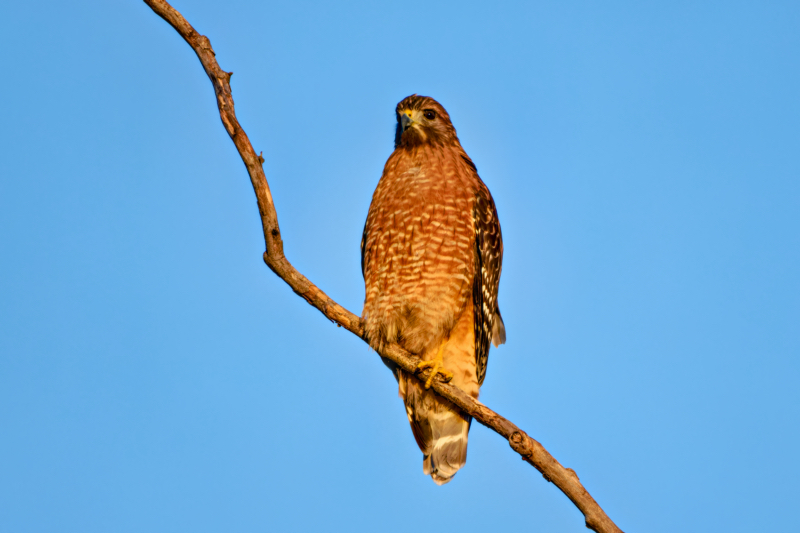I had the opportunity to photograph this Red-shouldered Hawk at the Sequoyah National Wildlife Refuge in Oklahoma on September 20, 2022. I captured this image while parked on the auto tour road, using my pickup truck as a blind to avoid startling the bird. The hawk was perched on a branch, surveying the landscape for potential prey, allowing for an ideal photographic opportunity.

Camera Setup and Settings
For this shot, I used a Canon EOS R7 with an 800mm lens. Here were the specific camera settings:
- Date: 9/20/22
- Time: 7:32:36 AM
- Focal Length: 800mm
- ISO: 1000
- Aperture: f/11
- Shutter Speed: 1/1000 sec
- Exposure Compensation: +0.3
The choice of an 800mm lens allowed me to capture the hawk from a distance without disturbing it. Shooting at f/11 provided a deep enough depth of field to keep the hawk’s details in focus while slightly blurring the background, creating separation between the subject and its surroundings. The shutter speed of 1/1000 sec was fast enough to capture any sudden movements the bird might make, ensuring a sharp image. The ISO setting of 1000 helped achieve a balanced exposure in the early morning light, while the +0.3 exposure compensation slightly brightened the image to enhance the hawk’s features.
Red-shouldered Hawk Characteristics and Behavior
Red-shouldered Hawks are medium-sized raptors that are common throughout much of the eastern and coastal United States. They are easily recognized by their reddish-brown shoulders, barred chest, and distinctive black-and-white checkered pattern on the wings. The hawk I photographed had vivid plumage, indicating that it was likely an adult. Juvenile Red-shouldered Hawks tend to be more muted in color with streaked brown feathers.
These hawks typically hunt from a perch, scanning the ground for small mammals, amphibians, and reptiles. Their preferred habitat includes wooded areas near water, making Sequoyah National Wildlife Refuge an ideal location for observing them. Red-shouldered Hawks are known for their distinctive, high-pitched calls that sound like “kee-ah, kee-ah,” which they use to communicate with each other, especially during breeding season.
Tips for Photographing Birds of Prey
- Use a Telephoto Lens: A lens with a focal length of at least 400mm is recommended for capturing details from a distance. An 800mm lens, like the one I used, can help you get closer shots without disturbing the bird.
- Shoot in Aperture Priority Mode: This mode allows you to control the depth of field while the camera automatically adjusts the shutter speed for optimal exposure.
- Stabilize Your Camera: When shooting with long focal lengths, use a bean bag, window mount, or tripod to stabilize your camera and reduce camera shake.
- Pay Attention to Lighting: Early morning and late afternoon provide soft lighting that enhances the details of the bird’s feathers and avoids harsh shadows.
- Use Your Vehicle as a Blind: Birds of prey are often less wary of vehicles than humans on foot. Shooting from inside a parked vehicle can help you get closer without spooking the bird.
The Importance of Sequoyah National Wildlife Refuge
The Sequoyah National Wildlife Refuge is a haven for a wide variety of bird species, including raptors like the Red-shouldered Hawk. Its mix of wetlands, wooded areas, and open fields provides ample hunting grounds for birds of prey, as well as suitable habitats for many other species. The auto tour road offers birdwatchers and photographers a unique opportunity to observe wildlife up close without leaving the vehicle, minimizing disturbances to the animals.
Observations from the Morning Shoot
The early morning timing of this photograph was ideal for bird activity. Raptors like Red-shouldered Hawks are often more active during this time, hunting for their first meal of the day. The cool temperatures and soft light also made it easier to capture the intricate details of the hawk’s plumage. While perched, the hawk scanned the surroundings, occasionally shifting its gaze to follow potential prey. This behavior allowed me to take multiple shots while it remained relatively still.
Capturing this Red-shouldered Hawk was a reminder of the refuge’s diverse wildlife and the opportunities it provides for wildlife photographers. Encounters like these highlight the importance of protecting natural areas where birds of prey can thrive and continue to play their role in the ecosystem.
